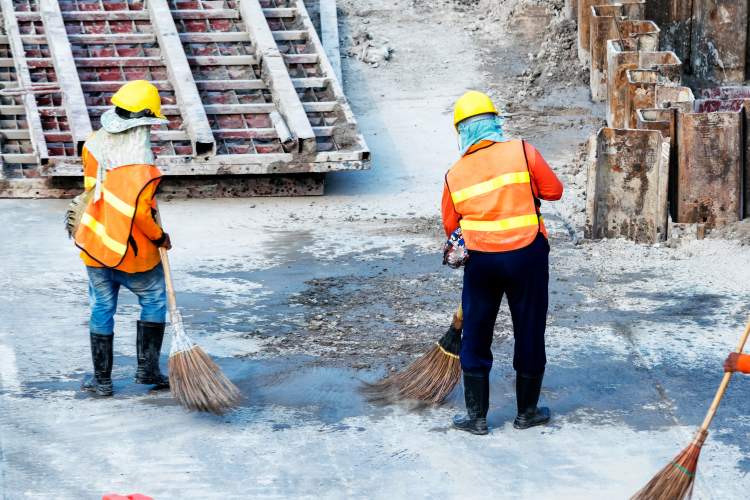For many construction projects, owners want to begin using or occupying the building as soon as possible — even if there are still minor details that need to be completed. For that reason, many contracts include the term “substantial completion.” Substantial completion refers to when the building can be used for its intended purpose, even if it is not considered absolutely complete.
But what makes a project substantially complete, and what does that mean for the subcontractors involved in the project — including when they get paid? Find out below.
Table of Contents
What Is Substantial Completion?
In construction, substantial completion is a legal term often used in contracts between project owners and contractors. It marks the point when the project is considered sufficiently complete. In general, this means that only minor, corrective, or warranty work remains.
Why is substantial completion important for contractors and subcontractors? Typically, substantial completion marks the point of the project when the owner is responsible for paying the contractor or subcontractors the remainder of their fees.
How Is Substantial Completion Determined?
There is no set definition of substantial completion. However, many states have adopted the definition from the American Institute of Architects (AIA), which states that substantial completion is “the stage in the progress of the work when the work or designated portion is sufficiently complete in accordance with the contract documents so that the owner can occupy or use the work for its intended purpose.”
This still leaves room for interpretation, so many project owners aim to specify what marks substantial completion in the project contract. For example, the owner may decide that substantial completion is reached when the certificate of occupancy is signed. Alternatively, the owner and contractor may develop a checklist that includes the items that must be completed to reach the substantial completion milestone. In addition, many contracts will call for a signed certificate of substantial completion to certify when the building is ready for use.
In any case, it’s important that contractors and subcontractors understand how substantial completion is defined for each project, so they can know when to expect payment — and what to do if they don’t receive that payment on time.

Who Signs the Certificate of Substantial Completion?
If the project owner opts to issue a certificate of substantial completion or the contractor requests one, it is the responsibility of the architect on the project to inspect the site and issue the certificate. The certificate of substantial completion also includes a list of items remaining to be corrected or completed, as well as the timeline allotted for those items. Once the terms are agreed upon, the architect, contractor and owner sign the certificate.
The certificate of substantial completion is different from a certificate of occupancy. The certificate of occupancy is issued by a local building inspector. This establishes that the building is safe to occupy and utilize.
Substantial Completion vs. Final Completion
Substantial completion and final completion are the two final phases of a project. Substantial completion refers to when the building can be used for its intended purpose. Final completion occurs when the project is 100% complete and requires no additional work.
After the point of substantial completion, there are still some tasks that need to be completed. Often, these are punch list items that could include minor repairs, cleanup, or installations.
How Substantial Completion Affects Subcontractors
Substantial completion is an important milestone for subcontractors, because at that point they are entitled to payment. In fact, at this point, non-payment could be considered a breach of contract.
In some cases, contracts will include additional stipulations that might withhold a portion of the payment until the final completion. However, in general, contractors and subcontractors are able to receive payment when the project reaches substantial completion.
Subcontractors should also be aware that when the project reaches substantial completion, warranty periods commence and some limitation periods begin to run.
Effects on Warranties, Claims, Liability and Deadlines — What Subs Need to Know
The point of substantial completion triggers deadlines and critical dates in the construction timeline, such as the timelines for claims and warranties.
Warranties
The clock for warranty periods (also commonly known as one-year correction periods) begins once substantial completion has been established. During a warranty period, subcontractors are contractually obligated to correct defects in their work or materials.
Claims and Liability
Substantial completion also begins the timeline for the statue of repose. This establishes a time period during which an owner can make a claim for defects. In many states, the point of substantial completion also begins the clock for construction lien claims and payment bond claims.
However, substantial completion also marks the point when contractors and subcontractors are released from certain types of liabilities, like construction delay claims and liquidated damages. At this point, a contractor also cannot generally be held liable for material breach of contract, since the project has performed sufficient work to get the project to this point.
Worried About Not Getting Paid on Time? Billd Can Help
Defining substantial completion early in the project can be beneficial to general contractors and subcontractors. In that case, everyone knows exactly when to expect payments and when certain timelines are triggered.
However, because substantial completion is not always concretely defined, there is still a possibility of payment delays. And if contractors aren’t paid on time, they may not be able to pay their subcontractors or suppliers on time.
If you’re worried about not getting paid on time, Billd can help. With Billd, you can close any potential cash-flow gaps and reduce your stress about when you will get paid. To learn more about how we can work with you to help you keep projects and payments on track, contact us.








